
Beginning Object-Oriented ASP.NET 2.0 with VB.NET From Novice to Professional
.pdf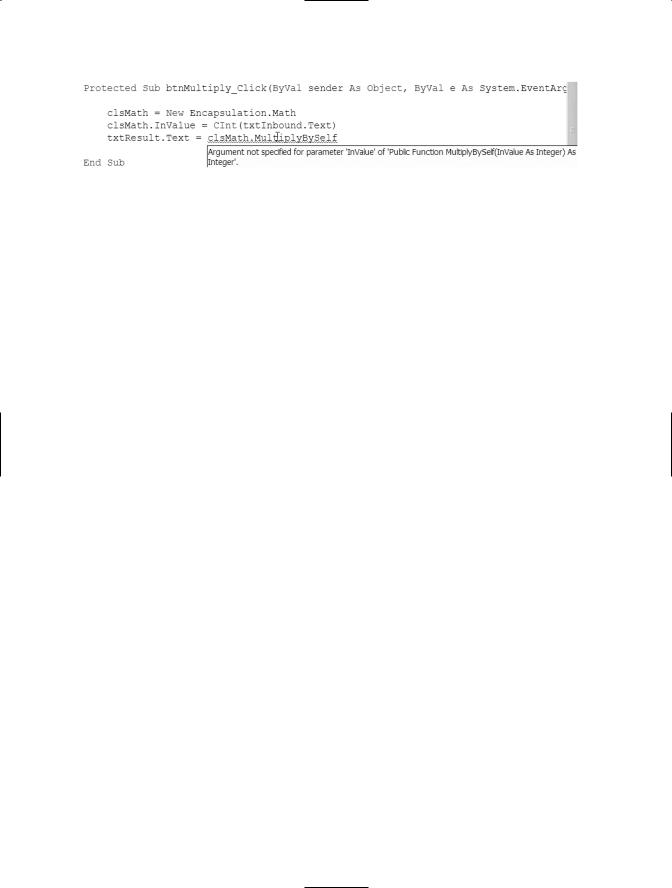
C H A P T E R 4 ■ E N C A P S U L AT I O N |
69 |
Figure 4-17. Error after interface was broken
The good news is that because of the way the .NET Framework and VS2005 work, your application did not break immediately as it would have in the past. Your application has its own copy of the .dll file and wasn’t impacted by the change you made. However, you can see how a change to the interface or the way that an encapsulated class is implemented can have an impact on any client application that uses it.
Conclusion
In this chapter, I’ve provided an overview of both encapsulation and information hiding. I’ve also showed you how information hiding is implemented within VB.NET and encapsulation can be used to create class libraries that can be used by other applications. Finally, I showed you what can happen when the interface of an encapsulated class is changed and existing clients attempt to use it. Chapter 5 will cover the concept of inheritance and how it can extend classes and the encapsulation of classes.


C H A P T E R 5
■ ■ ■
Inheritance
In this chapter, I’ll introduce the concepts of inheritance, overriding, and abstract classes and how to implement them within VB.NET.
Inheritance
Inheritance within OOP is the ability for one class to copy another class but also add its own functionality. Inheritance allows you to develop one class, called the base class, which contains core functionality and properties, and then copy it to another class, called the derived class. A derived class can include new methods and properties, but its base class is left unchanged.
Inheritance is important because it allows you to copy core functionality from other classes to a new class. Without this concept, you would need to maintain all of those classes if anything changed in the core functionality. However, with inheritance you can define the core functionality in one class and then inherit the functionality from that class to make other classes. Any change to the core functionality in the base class (the one you inherited from) would automatically be reflected in the derived classes (those inheriting the base class).
One rule of thumb to use when determining if you want to use inheritance is whether an “is-a” scenario exists. Later in the book I discuss a business process for a help desk application. In that case, a user may be a general user, a technician, or a help desk manager. The core information about a user is the same, but there are additional “features” available for a technician or help desk manager. So, the technician and the help desk manager are both general users. Therefore an “is-a” relationship exists between both the technician and user and the help desk manager and user.
A payroll application can also be a real-world example of inheritance. Say you have two types of employees: salaried and hourly. Both have some information in common, such as a first and last name, date of birth, and address. However, salaried employees also have salaries and per-pay amounts, whereas hourly employees have an hourly wage and a running count of the number of hours they’ve worked. A salaried employee “is-an” employee and an hourly employee “is-an” employee. This means that the base class
71

72 C H A P T E R 5 ■ I N H E R I TA N C E
would be Employee, and two classes (Salaried and Hourly) can be derived from the base class. You would create the base class (Employee) containing the core data and functionality such as the first name, last name, date of birth, and address. Next you would create a class called SalaryEmployee that inherits the Employee class and also adds the salary and per-pay amount as properties. Then create a class called HourlyEmployee that inherits the Employee class and also adds hourly wage and the number of hours worked as properties.
Inheritance in VB.NET
Within VB.NET, all classes are inheritable by default unless marked with the NotInheritable keyword. You can inherit from other classes within a project or from classes within other applications (assemblies) that your project references (see Chapter 4 for more information on how to add a project reference).
VB.NET allows only single inheritance, which means a class can only inherit from one other class. You can’t have a class that inherits from more than one class. To prevent exposing any private items within the base class, the scope of the class (Private, Public, and so on) of a derived class must be equal to or more restrictive than the base class. This means a public class can’t inherit from a private class.
The MustInherit class scope (access modifier) can be used in the base class to specify that the class must be inherited from and can’t be used directly. If a class has the MustInherit access modifier, you must derive a class from it.
To see how inheritance works in VB.NET, create a new web site called Chapter5. After you’ve created this project, add a new class file called Employee. Declare three private variables (strFirstName,strLastName,dteDateofBirth) and define three public properties (First Name, Last Name, Date of Birth). Finally, add a public sub called ConcatName as defined in the following code:
Public Class Employee
Private strFirstName As String
Private strLastName As String
Private dteDateOfBirth As Date
Public Property FirstName() As String Get
Return strFirstName End Get
Set(ByVal value As String) strFirstName = value
End Set End Property
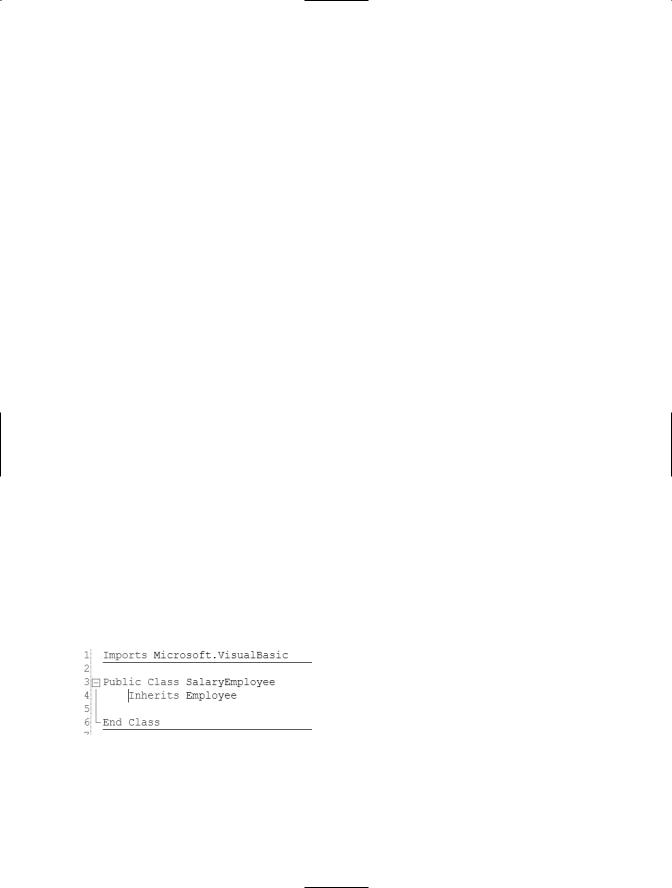
C H A P T E R 5 ■ I N H E R I TA N C E |
73 |
Public Property LastName() As String Get
Return strLastName End Get
Set(ByVal value As String) strLastName = value
End Set End Property
Public Property DateOfBirth() As Date Get
Return DteDateOfBirth End Get
Set(ByVal value As Date) DteDateOfBirth = value
End Set End Property
Public Sub ConCatName(ByVal FirstName As String, ByVal LastName As String, ByRef FullName As String)
FullName = FirstName & LastName End Sub
End Class
After you create the Employee class file, create a new class file called SalaryEmployee.vb. When you’ve created the SalaryEmployee class, add the following line immediately after the Public Class SalaryEmployee code:
Inherits Employee
This line of code will allow the SalaryEmployee class to inherit the existing Employee class. Your code file for SalaryEmployee.vb should look like Figure 5-1.
Figure 5-1. Inheriting the Employee class
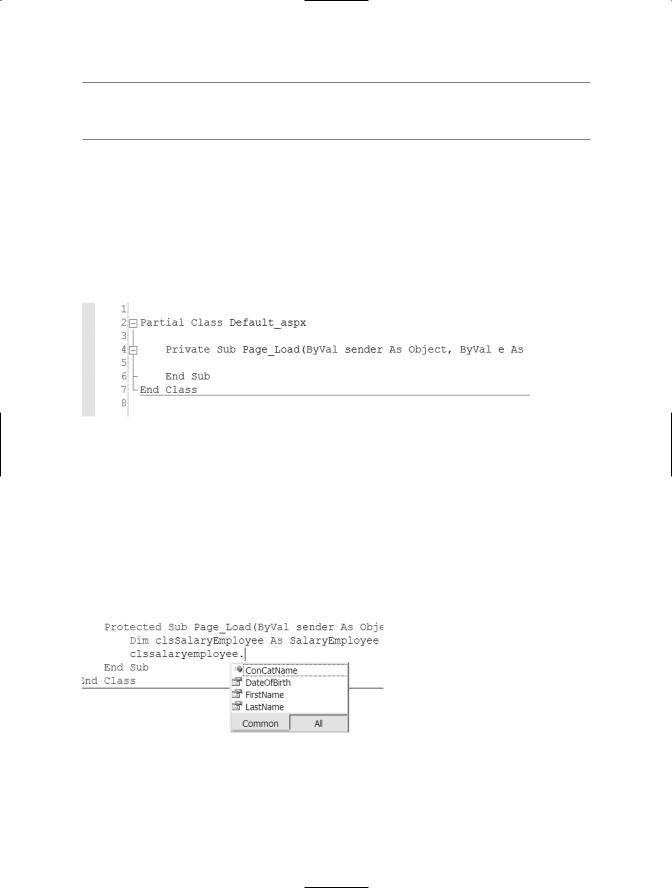
74 C H A P T E R 5 ■ I N H E R I TA N C E
■Tip An alternative to using the two lines is to include both the inherits and the class name on the same line, such as Public Class SalaryEmployee:Inherits Employee.
At this time, you have two classes, the original Employee class, which is your base class, and the SalaryEmployee class, which is the derived class.
To see how an inherited class works, save the SalaryEmployee class and then open the Default.aspx.vb file. Choose Page from the drop-down list at the top left of the page and then Load from the top right of the page. This will create the Page_Load sub as shown in Figure 5-2.
Figure 5-2. Revised Default.aspx.vb file
Now declare a variable of type SalaryEmployee with the following line of code after the Private Sub Page_Load code line (place this on line 5):
Dim clsSalaryEmployee as SalaryEmployee
On the next line type clsSalaryEmployee followed by a period, and the IntelliSense drop-down list will appear as shown in Figure 5-3.
Figure 5-3. IntelliSense for SalaryEmployee class
This shows you that the SalaryEmployee class did in fact inherit all of the public methods and properties of the Employee class. Now the SalaryEmployee class is an exact copy of the Employee class.
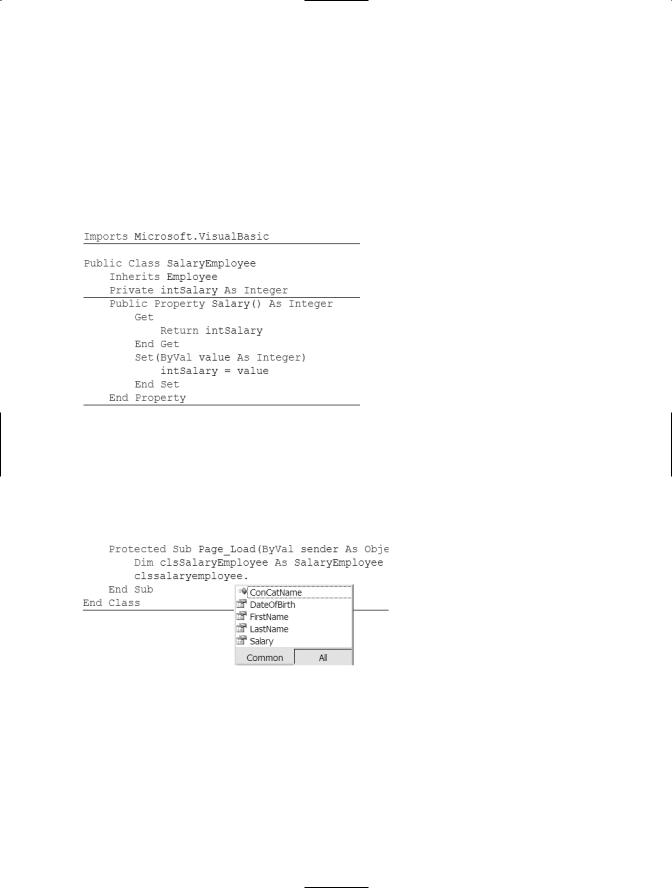
C H A P T E R 5 ■ I N H E R I TA N C E |
75 |
However, this will not complete the functionality that would be required for a salaried employee. Instead, this will just allow the SalaryEmployee class to have the core functionality that is required for all employees. To add the specific functionality that is needed for a salaried employee, methods and properties must be added to the SalaryEmployee class.
Open the SalaryEmployee.vb file. Add a new private variable called intSalary as an integer and then an integer public property called Salary. The SalaryEmployee.vb file should look like Figure 5-4 when you are done.
Figure 5-4. Updating the SalaryEmployee class
Return to the Default.aspx.vb file and, if you do not already have clsSalaryEmployee followed by a period within the page_load sub, add that line again so that the IntelliSense for clsSalaryEmployee is shown as in Figure 5-5.
Figure 5-5. Revised IntelliSense for clsSalaryEmployee
As you can see, the public property for Salary is accessible in the SalaryEmployee class. However, the Salary public property would not be available for an instance of the Employee class, since the property was only added to the derived SalaryEmployee class. To show this, create a new variable called clsEmployee as an instance of the Employee class within the Page_Load sub in the Default.aspx.vb page. The Default.aspx.vb page should look like Figure 5-6.
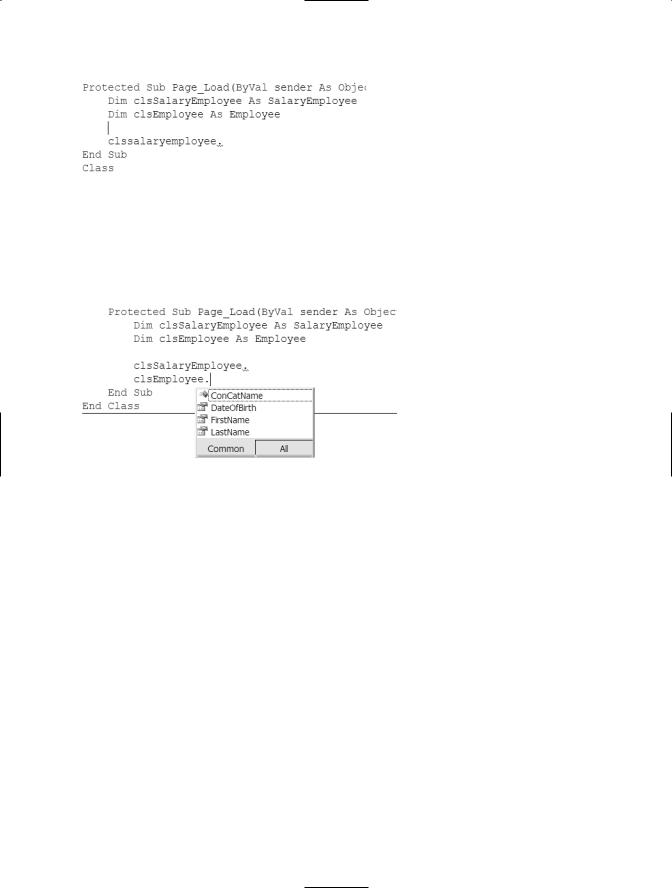
76 C H A P T E R 5 ■ I N H E R I TA N C E
Figure 5-6. Revised Default.aspx.vb file
After the line that was used to show the interface (properties and methods) of the SalaryEmployee class (clsSalaryEmployee), add a line with just clsEmployee followed by a period. This will show the IntelliSense for clsEmployee, as shown in Figure 5-7.
Figure 5-7. IntelliSense for clsEmployee class
Notice that the Salary public property is not available for the Employee class—it is only available for the SalaryEmployee class, because the public property was added to the derived class, Salaried, instead of the base class, Employee.
Overriding
A derived class inherits methods and properties from the base class. You can, however, change the behavior of a base method in the derived class by overriding the base method. If Object A is the base class and contains a method called DetermineBenefits, and Object B inherits from Object A, it’s possible for Object B to implement its own method called DetermineBenefits and that Object B’s DetermineBenefits method will be used. In general, the base class implements the default behavior for the method, and if the derived class requires special implementation details, the derived class will override the default method provided by the base class. The Overridable keyword allows a property or method to be overridden in the derived class. In the example I just gave you, Object A would need to have Overridable as part of its declaration of the DetermineBenefits method. The Overrides keyword overrides an overridable property or method from the base class.

C H A P T E R 5 ■ I N H E R I TA N C E |
77 |
In the example I just gave you, Object B would need to use the Overrides keyword as part of its declaration of the DetermineBenefits method. The NotOverridable keyword prevents a property or method in the base class from being overridden in the inherited class. Public methods are NotOverridable by default. The MustOverride keyword requires the derived class to override the property or method from the base class.
Continuing with the employee example used in this chapter, there is typically a difference in benefits between the hourly employee, salaried employee, and executive. So, you’ll need to introduce a new class, called ExecutiveEmployee. The hourly and salaried employees in this example have their benefits determined the same way, but the benefits of the executives are determined in a different way. To implement this, a method called DetermineBenefits that is overridable will be added to the Employee class. The Employee class will provide a default implementation that will work for the salaried and hourly employees, but that will be overridden for the executive employees.
First, add a new overridable method to the employee base method. Add the following code to the Employee class:
Public Overridable Function DetermineBenefits() As String
Return "70% paid health care, dental insurance, life insurance"
End Function
Now create a new class called ExecutiveEmployee and call the file ExecutiveEmployee.vb. Next, add :Inherits Employee at the end of the class declaration so that the class declaration looks like Public class ExecutiveEmployee:Inherits Employee. Add the following code to the Executive class to implement the DetermineBenefits method:
Public Overrides Function DetermineBenefits() As String
Return "20% bonus, country club membership"
End Function
To demonstrate how this works, open the Default.aspx page and add a new textbox control called txtsalaried and a label called lblsalaried, with a text of salaried benefits. Next, add a button called btnsalaried, with a text of salaried. Then, add a new textbox control called txtexecutive and a label called lblexecutive, with a text of executive benefits. Finally, add a button called btnexecutive with a text of executive. The resulting page is shown in Figure 5-8.
Figure 5-8. Completed Default.aspx page

78 C H A P T E R 5 ■ I N H E R I TA N C E
Double-click the Salaried button. This will open the Default.aspx.vb file and create a sub for the Salaried button’s button click event. When the page opens, find the Page_Load sub that was created earlier in the chapter and delete any code fragments that might exist. Above the Page_Load sub line, and below the class declaration, add two private variables called clsSalaryEmployee and clsExecutiveEmployee. Each of these will create an instance of its respective class. The code in Default.aspx.vb should look like Figure 5-9.
Figure 5-9. Added variables
After you’ve added the variables, add a line of code to the btnSalaried_Click sub to create a new instance of the SalaryEmployee class. Next, add a line to assign the value returned from the DetermineBenefits method of the salaried class to the txtsalaried text box, as shown in the this code:
clsSalaryEmployee = new SalaryEmployee txtsalaried.Text = clsSalaryEmployee.DetermineBenefits
Now choose btnexecutive from the left drop-down list at the top of the page. After choosing btnexecutive, choose Click from the right drop-down list at the top of the page. This will create a btnexecutive_click sub. Within this newly created sub, add the following code to create an instance of the executive class and then assign the string returned from DetermineBenefits:
clsExecutiveEmployee= New ExecutiveEmployee txtexecutive.Text = clsExecutiveEmployee.DetermineBenefits
To test this out, choose Build web site from the Build menu and then choose Start without debugging from the Debug menu. The Default.aspx page with the two labels, the two text boxes, and the two buttons will appear. Click the Salaried button. The text “70% paid health care, dental insurance, life insurance” will appear in the text box next to the
